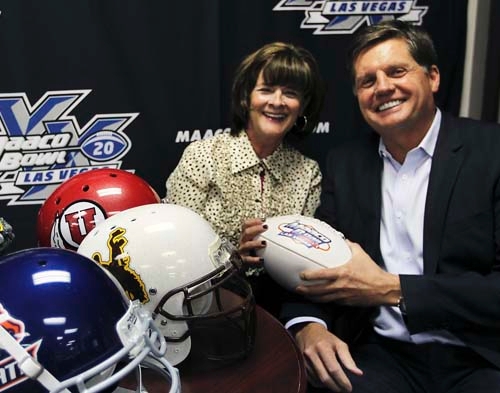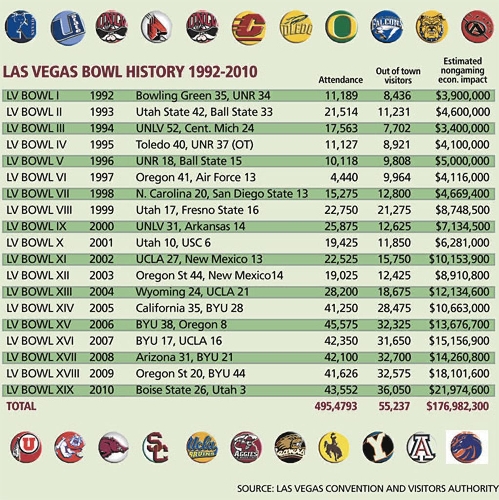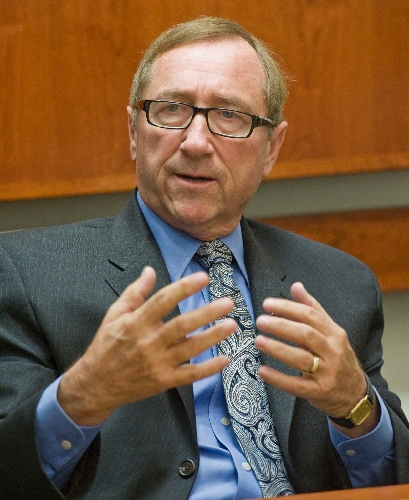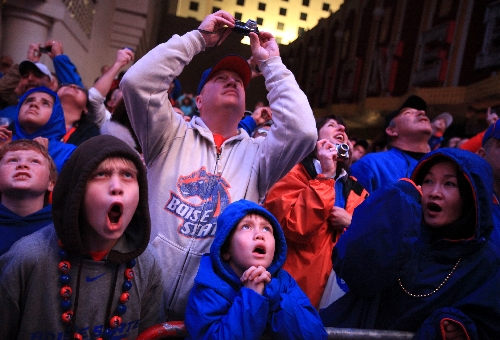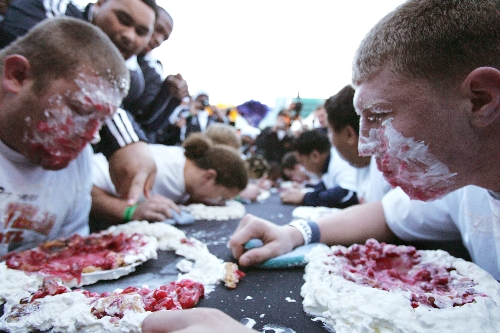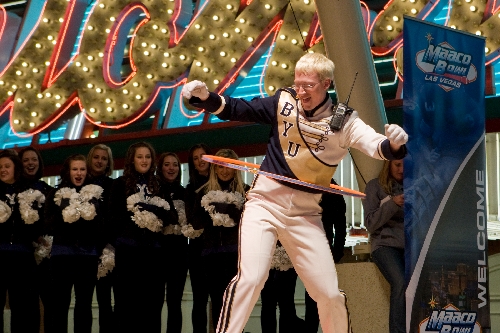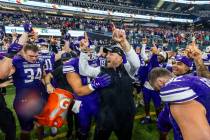Las Vegas Bowl grows into big-time event
When three Las Vegas tourism officials traveled to Toledo, Ohio, in early 1992, they weren't sure what kind of reception to expect.
Las Vegas was pitching the idea of bringing a college football bowl game between the champions of the Mid-American Conference and the Big West to the Sam Boyd Silver Bowl in December. The California Raisin Bowl in Fresno had run its course and the conferences were seeking a new showcase for their rivalry.
Las Vegas was looking for an event to fill empty hotel rooms and bring the local economy some business activity during the mid-December downtime.
It turned out the idea wasn't that tough a sell.
"We met with them, we made the pitch and that was it," recalled Rob Dondero, an executive vice president with R&R Partners. "I never understood why the California guys never made a counter offer."
The Las Vegas Bowl is celebrating its 20th anniversary and has evolved from a means to plug slow visitation to a valuable week on the city's special event calendar.
In the past 19 years, the Las Vegas Convention and Visitors Authority reports the game has brought more than 355,000 visitors to Las Vegas and accounted for almost $177 million in nongaming economic impact during a traditionally slow period.
Tourism officials estimate gaming revenues from visitors associated with the bowl have totaled $98.5 million, including the five straight years Brigham Young University and its socially conservative fan base came to Las Vegas.
The Dec. 22 Las Vegas Bowl between Boise State University and Arizona State University is expected to be the game's seventh straight sellout, bringing more than 40,000 fans to Sam Boyd Stadium. The game is referred to nationally as the MAACO Bowl Las Vegas in deference the current title sponsor, MAACO Collision Repair and Auto Painting.
In the days leading up to the game, players, coaches and fans are expected to participate in several events around town, including a welcoming reception and pep rally at the Fremont Street Experience, hospital visits, shopping excursions and luncheons.
"Our bowl committee has done a pretty good job of getting people from all walks of life involved in the game," Las Vegas Bowl Executive Director Tina Kunzer-Murphy said. "In this town, people feel a sense of ownership and that's made the game successful. People from Boulder City to Summerlin are fully engaged in this bowl."
Tourism leaders said the game is a marketing vehicle for Las Vegas. The Las Vegas Bowl is televised on ESPN and is heard on the Sports USA Radio Network.
A POPULAR REGIONAL CONTEST
Dondero, who is now president of the bowl's executive board of directors, considers the Las Vegas Bowl at the top of the third tier of college bowl games, which take place before Christmas. A second tier of games happens between Christmas and New Year's, followed by the traditional New Year's Day games.
This year's payout of $1.1 million per school won't match the nearly $20 million per team that goes to the BCS Championship game participants. The game, however, has become a popular regional contest between schools from the Mountain West Conference and the Pac-12.
"The feedback from participants, to fans, to the conferences, and the officials has always been very good," Dondero said. "Customer service is what we do well. It's a good time of year for the game and the teams are treated well when they get here."
The Las Vegas Bowl is the 16th longest running out of the 34 bowls now in existence, not counting the BCS Championship game, which is a separate entity. Nearly 30 other bowl games have gone out of business in the past 20 years. Five bowls, including the Seattle Bowl and the International Bowl in Toronto, came and went during the Las Vegas Bowl's tenure.
Before 1985, the Las Vegas hotel-casino industry seemingly shut down between Thanksgiving and Christmas, kicking in again on Dec. 26 as the New Year's holiday neared.
That was the year the National Finals Rodeo started coming to town, packing the Strip and downtown casinos for 10 days in the first half of December.
Dondero said tourism leaders thought a college football bowl game could spike business for two or three days midmonth, and credits the late Herb McDonald, head of Las Vegas Events, with suggesting a bowl game.
DESTINATION-FUELED SUCCESS
It was an easy sell.
"It was an education process at first about the bowl's potential," said Las Vegas Convention and Visitors Authority Chief Executive Officer Rossi Ralenkotter, who traveled to Toledo with Dondero and McDonald for the initial pitch. "The game's success is really due to the destination. The event has grown and matured over the years to include all the excitement and pageantry of a college bowl game."
The initial Las Vegas Bowl on Dec. 18, 1992, attracted 11,189 fans to what was then a 32,000-seat stadium to watch Bowling Green State University defeat University of Nevada, Reno, 35-34. The game brought 8,436 out-of-town visitors to Las Vegas, who had an estimated $3.9 million in nongaming economic impact.
That year, the payout was $223,000 per team.
The results have greatly improved.
The 2006 contest between BYU and Oregon attracted a state-record 44,615 fans to see a football game.
"Attendance wasn't strong at the beginning, but we knew things would improve," Ralenkotter said.
The game has had several title sponsors and operated under various names, such as the Sega Sports Las Vegas Bowl and the Pioneer PureVision Las Vegas Bowl.
"It's always been part of our strategy to keep our name in the bowl's title," Ralenkotter said. "That's also been part of our success."
OPENING TO BOWL SEASON
During its first decade, the Las Vegas Bowl kicked off the college bowl season.
"That gave us a little uniqueness and was a little bit of a marketing tool we could use to promote the game," Dondero said.
After the Mid-American Conference and the Big West were dropped, teams were brought in from various leagues, including the Atlantic Coast Conference and Southeastern Conference. The game has been played on several dates, including Christmas Day in 2001 and 2002 and Christmas Eve in 2003.
The Las Vegas Bowl's biggest changes came in 2001.
ESPN Regional Television acquired ownership and management of the Las Vegas Bowl and assumed responsibility for the game's organization, operation, sponsorship and marketing efforts. Kunzer-Murphy, a longtime University of Nevada, Las Vegas athletic department official involved in the bowl game from its outset, was named executive director, which is a full-time year-round position.
A board of directors of local business leaders is also involved in managing and choosing the teams for the game.
The move allowed the Las Vegas Bowl to be televised by ESPN and become part of ESPN's Capital One Bowl Week promotion, which gives the game extended exposure.
The bowl then signed with the Mountain West Conference and the Pac-10 (now Pac-12) Conference to provide participants. The agreement was renewed in 2009 and goes through 2013.
Kunzer-Murphy said the two conferences were attractive to the Las Vegas hotel industry, which bid to host the schools. This year, Mandalay Bay is home to Arizona State and its fan base while the Hard Rock Hotel will take Boise State's contingent. Over the years, nine different hotel-casinos have served as host properties.
Dondero said moving the host hotels appeals to the convention and visitors authority's mission of promoting the destination.
Being a regional contest also means any school can get to Las Vegas through a 90-minute flight.
"Things changed dramatically when we brought in the Pac-10," Kunzer-Murphy said. "These are schools that are all close in proximity to Las Vegas. So it's an easy drive or flight in and out. The conferences like the cost savings."
"A lot of these schools are in our top feeder markets," Dondero said. "They know how to get here."
COMFORTABLE ON THE CALENDAR
Kunzer-Murphy and Dondero said the bowl committee has been approached about moving the game to after Christmas. But the current schedule helps fill hotels at a time when occupancy and rates are low, while a switch would conflict with a peak time for hotel rates.
And the Las Vegas Bowl won't crack into the BCS game lineup without a larger stadium.
"Tina and ESPN have done an incredible job maximizing the sponsor side," Dondero said. "But without being able to sell more tickets, there just isn't enough revenue."
Other potential vehicles to grow the bowl include a college basketball tournament to coincide with the game. In 2008, University of Arizona's basketball team played in the morning and the football team beat BYU 31-21 that evening.
Otherwise, the tourism and business communities like the bowl as it is.
"Special events, like the Las Vegas Bowl, particularly around a slow period of time, are great examples of what is done in the community to make Las Vegas economically strong," said MGM Resorts International spokesman Alan Feldman.
Las Vegas Chamber of Commerce CEO Kristin McMillan said the game and festivities have a positive impact beyond hotel, restaurant and retail businesses.
"The business community has become involved in the game on a much larger scale," McMillan said. "The game gives the business community an opportunity to showcase its products and services."
Contact reporter Howard Stutz at hstutz@reviewjournal.com or 702-477-3871. Follow @howardstutz on Twitter.
Las Vegas Bowl gets its own hall of fame
To help commemorate the Las Vegas Bowl's 20th anniversary, four individuals will be inducted into a new Hall of Fame this month.
The group will be made up of Steven Jackson (player), Anthony Calvillo (player), John Robinson (coach) and Rossi Ralenkotter (founding father).
Ralenkotter, chief executive officer of the Las Vegas Convention and Visitors Authority, was part of the group that brought the game to Las Vegas in 1992.
Calvillo, a quarterback, led Utah State to a 42-33 win over Ball State in the second Las Vegas Bowl in 1993. He has gone on to an 18-year career in the Canadian Football League, winning three Grey Cup championships. This past season, Calvillo became the most productive quarterback in the history of professional football with 73,412 passing yards.
Jackson was born and raised in Las Vegas and played high school football at Eldorado. A running back, he helped Oregon State beat New Mexico 55-14 in the 12th Las Vegas Bowl in 2003. He is now in his eighth season with the St. Louis Rams.
Robinson earned the best winning percentage in NCAA bowl history for a coach with at least eight appearances when he led the University of Nevada, Las Vegas to a 31-14 win over Arkansas in the 2000 Las Vegas Bowl. Robinson, who also coached the University of Southern California, coached UNLV from 1999 to 2004.
The Las Vegas Bowl Hall of Fame plans to welcome a class every five years but there is no time requirement to be eligible for induction. Inductees will fall under the following categories: player, coach, founding father and contributor.



